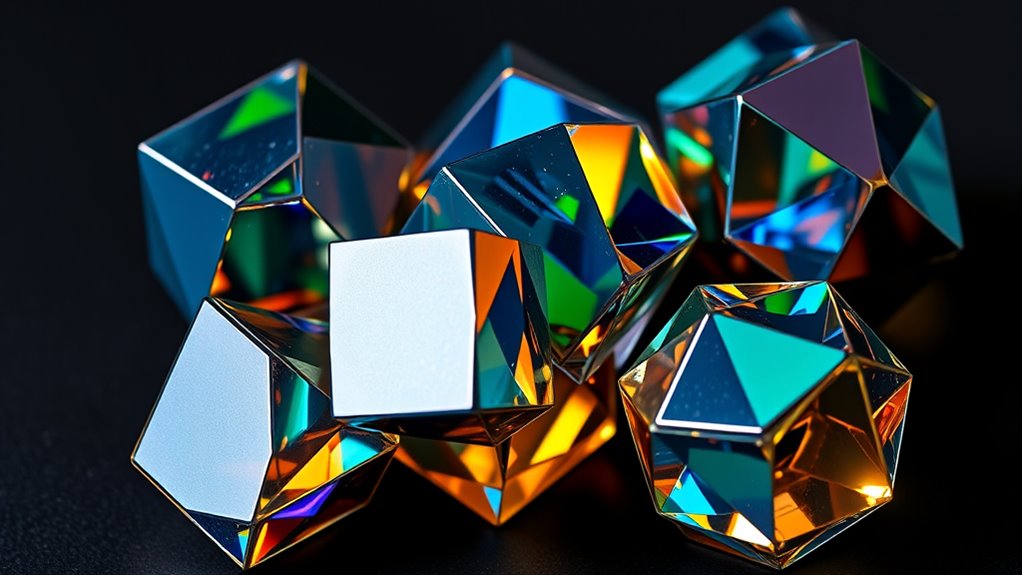Polygons and polyhedra are more fascinating than you think because their geometric properties shape the world around you, from stable structures to efficient designs. They influence architecture, engineering, and nature’s patterns, revealing elegant symmetry and clever patterns like tessellations. Understanding how these shapes fit and connect helps explain everything from honeycombs to skyscrapers. Keep exploring, and you’ll discover the surprising ways these shapes unleash innovative ideas and the beauty hidden in everyday forms.
Key Takeaways
- Their geometric properties influence real-world design, from architecture to aerospace, showcasing practical applications beyond basic shapes.
- Polygons and polyhedra enable efficient patterns like tessellations, impacting art, urban planning, and material science.
- Their symmetry and face adjacency reveal complex spatial reasoning, inspiring innovation in technology and engineering.
- These shapes mimic natural structures like honeycombs, demonstrating geometric efficiency and biological harmony.
- Understanding their mathematical elegance connects theory to tangible advancements in science, industry, and design.

Have you ever wondered what shapes make up the world around us? The answer lies in polygons and polyhedra—fundamental building blocks of geometry that are more than just mathematical concepts. These shapes possess unique geometric properties that determine their structure, symmetry, and behavior. Understanding these properties helps you see how they are woven into the fabric of everyday life, from the design of architecture and engineering to nature’s intricate patterns. Polygons, which are flat shapes with straight sides, and polyhedra, their three-dimensional counterparts, each have defining characteristics that make them fascinating. For example, the number of sides, angles, and the way faces connect reveal much about their stability and strength. These geometric properties govern how shapes can be combined or manipulated, enabling architects to create buildings that are both aesthetically pleasing and structurally sound. Additionally, the geometric properties of these shapes influence how they tessellate and fit together, affecting patterns and structural efficiency. When you look around, you’ll see that real-world applications of polygons and polyhedra are everywhere. In architecture, the hexagonal pattern of honeycombs maximizes space and strength, demonstrating how geometric efficiency is utilized by nature and engineers alike. In automotive and aerospace industries, polyhedral shapes contribute to the design of aerodynamic surfaces, reducing drag and enhancing performance. Even in digital graphics and video game design, polygons form the mesh that creates complex, lifelike models. The geometric properties of these shapes—such as angles, symmetry, and face adjacency—are essential in ensuring that these applications work effectively. Engineers rely on understanding the properties of polyhedra when designing bridges, skyscrapers, and even compact packaging solutions, because these shapes distribute stress evenly and optimize material usage. Furthermore, understanding the geometry behind these shapes reveals a deeper appreciation for their mathematical elegance. The way polygons tessellate, or fit together without gaps, influences everything from tile patterns to urban planning. Polyhedra, with their faces and vertices, reveal insights into symmetry and spatial reasoning—skills that are crucial in fields like robotics, computer science, and molecular chemistry. Recognizing how geometric properties govern the behavior of these shapes helps you see the interconnectedness of math and the physical world. It’s not just about abstract figures; it’s about how these shapes shape our environment and innovations. The more you explore their properties, the more you realize that polygons and polyhedra are not only fascinating but also integral to understanding and improving the world around you.
Frequently Asked Questions
How Do Polygons Relate to Real-World Architecture?
You see, polygons play a crucial role in real-world architecture by creating architectural tessellations that add visual interest and functionality. They help guarantee structural stability by distributing weight evenly across surfaces. When you observe buildings and pavements, you’ll notice how polygons shape their design, making structures both durable and aesthetically appealing. Their geometric properties are fundamental in designing efficient, stable, and mesmerizing architectural elements around you.
What Are the Applications of Polyhedra in Modern Technology?
Polyhedra play a essential role in modern technology by shaping structural frameworks and advancing material science. You’ll find them in architectural designs, aerospace structures, and nanotechnology, where their geometric stability enhances strength and durability. In material science, polyhedral models help develop new materials with specific properties. By understanding these complex shapes, you can appreciate how they contribute to innovative solutions in engineering and technology today.
How Do Polygons Influence Computer Graphics and Gaming?
Imagine polygons as the building blocks of your digital world. They shape everything you see in computer graphics and gaming, creating realistic environments and characters. Polygon tessellations guarantee seamless textures, while shading algorithms add depth and detail. Without them, your favorite games would look flat and dull. So, you can see how these simple shapes play a huge role in crafting immersive, vibrant virtual experiences you enjoy every day.
Can Polygons Be Used to Model Complex Biological Structures?
You can definitely use polygons for biological modeling, especially to represent complex cellular structures. Polygons help create detailed, accurate models of biological forms, making it easier to visualize and study cellular structures. By breaking down intricate shapes into polygons, you simplify the modeling process while maintaining precision. This approach enhances understanding of biological systems and aids in simulations, research, and educational tools, making polygons invaluable in biological and cellular modeling.
What Are the Mathematical Challenges in Classifying Irregular Polyhedra?
Imagine trying to untangle a complex knot; that’s what classifying irregular polyhedra feels like. You face tough mathematical challenges like computational complexity, which makes solving problems computationally demanding, and topological classification, where understanding how shapes connect and twist becomes tricky. These hurdles make it difficult to categorize irregular polyhedra systematically, but overcoming them reveals the intricate beauty hidden within these complex structures.
Conclusion
So, next time you see a polygon or polyhedron, remember they’re like hidden treasures waiting to be revealed. Their shapes are more than just lines and surfaces—they’re the building blocks of the universe, shaping everything around you. Think of them as the DNA of geometry, opening endless possibilities. Once you realize their fascinating complexity, you’ll see them not just as shapes, but as the universe’s own secret code, waiting for you to decipher.









